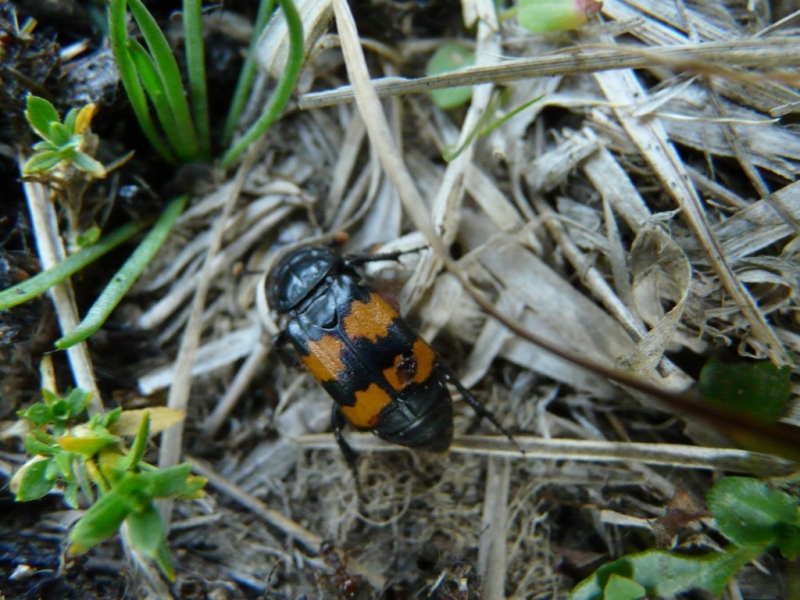|
|
|
|
|
Galleria Tassonomica
di
Natura Mediterraneo
|
 Nota! La determinazione degli insetti necessita quasi sempre di un'indicazione geografica e temporale precisa. Nota! La determinazione degli insetti necessita quasi sempre di un'indicazione geografica e temporale precisa.
Invitiamo quindi gli utenti ad inserire questi dati ogni volta che viene richiesta una determinazione o viene postata una foto di un insetto. I dati forniti dagli utenti ci consentiranno anche di attribuire un valore scientifico alle segnalazioni, contribuendo a migliorare e integrare le attuali conoscenze sulla distribuzione delle specie postate.
|
|
| Autore |
 Discussione Discussione  |
|
|
Marco Panella
Utente Junior
 
CittÓ: Roma

79 Messaggi
Tutti i Forum |
|
|
Klaas Rei▀mann
Utente Senior
   
CittÓ: Kamp-Lintfort, Nordreno-Vestfalia
Regione: Germany

1614 Messaggi
Tutti i Forum |
 Inserito il - 13 agosto 2012 : 20:29:29 Inserito il - 13 agosto 2012 : 20:29:29


|
I would need a bigger photo. Can't see enough to name this one (min. tripple the size of what you are showing in this thread).
Ciao
Klaas |
|
 |
|
|
Marco Panella
Utente Junior
 
CittÓ: Roma

79 Messaggi
Tutti i Forum |
 Inserito il - 16 agosto 2012 : 09:45:44 Inserito il - 16 agosto 2012 : 09:45:44


|
I hope this sizes of the picture is enough.
Do you have information about Nicrophorus sp. feeding not on carrions but on dung ?
Thank you
Immagine:

295,45 KB |
|
 |
|
|
Klaas Rei▀mann
Utente Senior
   
CittÓ: Kamp-Lintfort, Nordreno-Vestfalia
Regione: Germany

1614 Messaggi
Tutti i Forum |
 Inserito il - 18 agosto 2012 : 15:18:55 Inserito il - 18 agosto 2012 : 15:18:55


|
Hi Marco,
there would need of some more photos taken out of other perspectives. I wasn't sure if the tibiae of the hindlegs are straight or going in a bow. Those are straight, so it is no Necrophorus vespillo. Because of the red hindmark it is even no Necrophorus vespilloides. Necrophorus germanicus and Necrophorus humator are black all over (N. germanicus has got reddish Epipleura), Necrophorus nigricornis has got black antennae all over.
so far we do know its none of those species. But at this point we get problems. Necrophorus antennatus and N. vestigator do have yellow-golden hairs on head and Pronotum. There do not seem to be any of this, but they can be rubbed of and than we need the cavity of insertion of these hairs to see and the photo is to small for this by far. And I guess you're photo in original wouldn't show it to, because those insertions are to small.
If we do ignore this fact and go to the fact "no yellow-golden hairs, we have to decide if the beetle has got yellow hairs on the Abdomen (we need to see the bottom side) or not. If the bottom side is yellow haired it is Necrophorus fossor. If not we need to see if the tip of the Abdomen and if it is yellow haired or black haired. Is it yellow, it is N. investigator, if not it is N. sepultor. As you can see, there may be big problems.
I do speculate, because this species is most common of the unknown ones, it is Necrophorus fossor. But that's a guess, no identification.
Necrophorus and other Silphidae do not feed on dung. They even do not feed on carrion, but their larvae needs carrion for its development. The beetle itself is feed by the larvae of flies and other insects and therefor they are sometimes found in dung, hunting their prey.
Regards
Klaas |
|
 |
|
|
Marco Panella
Utente Junior
 
CittÓ: Roma

79 Messaggi
Tutti i Forum |
 Inserito il - 26 agosto 2012 : 12:50:05 Inserito il - 26 agosto 2012 : 12:50:05


|
| Thank you very much Klaas |
|
 |
|
|
Marco Panella
Utente Junior
 
CittÓ: Roma

79 Messaggi
Tutti i Forum |
 Inserito il - 26 agosto 2012 : 12:51:34 Inserito il - 26 agosto 2012 : 12:51:34


|
| .....I'm sorry but I dont'have other pictures |
|
 |
|
| |
 Discussione Discussione  |
|
|
|
 Natura Mediterraneo Natura Mediterraneo |
© 2003-2024 Natura Mediterraneo |
 |
|
Leps.it | Herp.it | Lynkos.net
|

 Forum
|
Registrati
|
Msg attivi
|
Msg Recenti
|
Msg Pvt
|
Utenti
|
Galleria |
Map |
Forum
|
Registrati
|
Msg attivi
|
Msg Recenti
|
Msg Pvt
|
Utenti
|
Galleria |
Map |